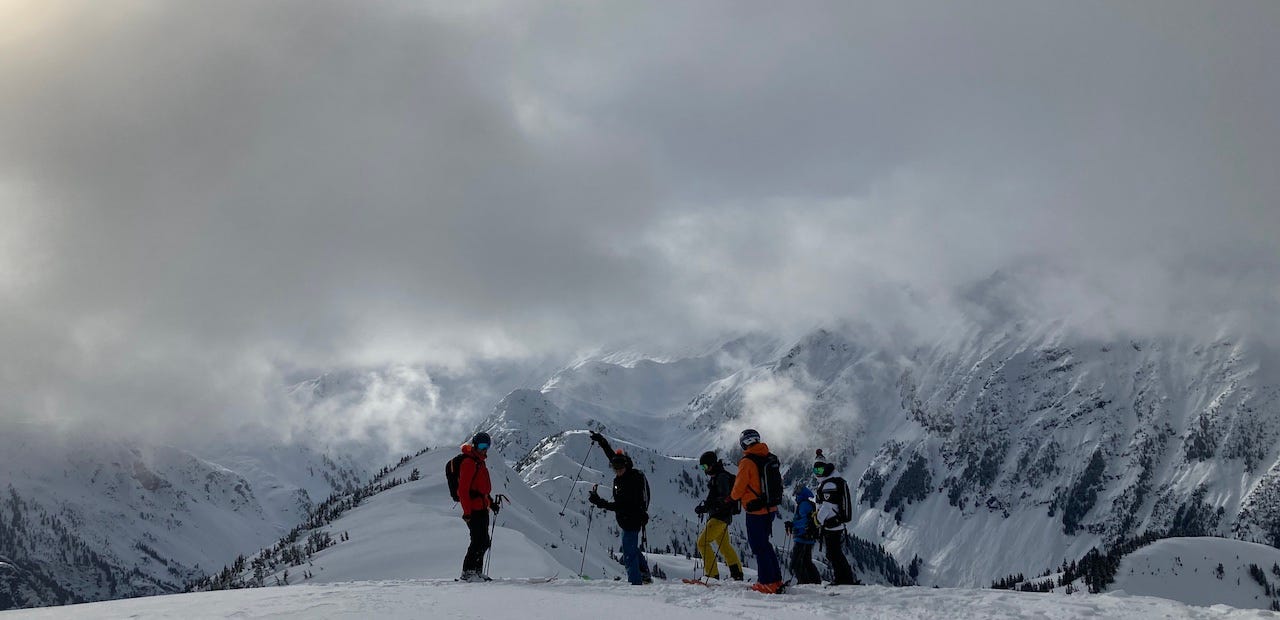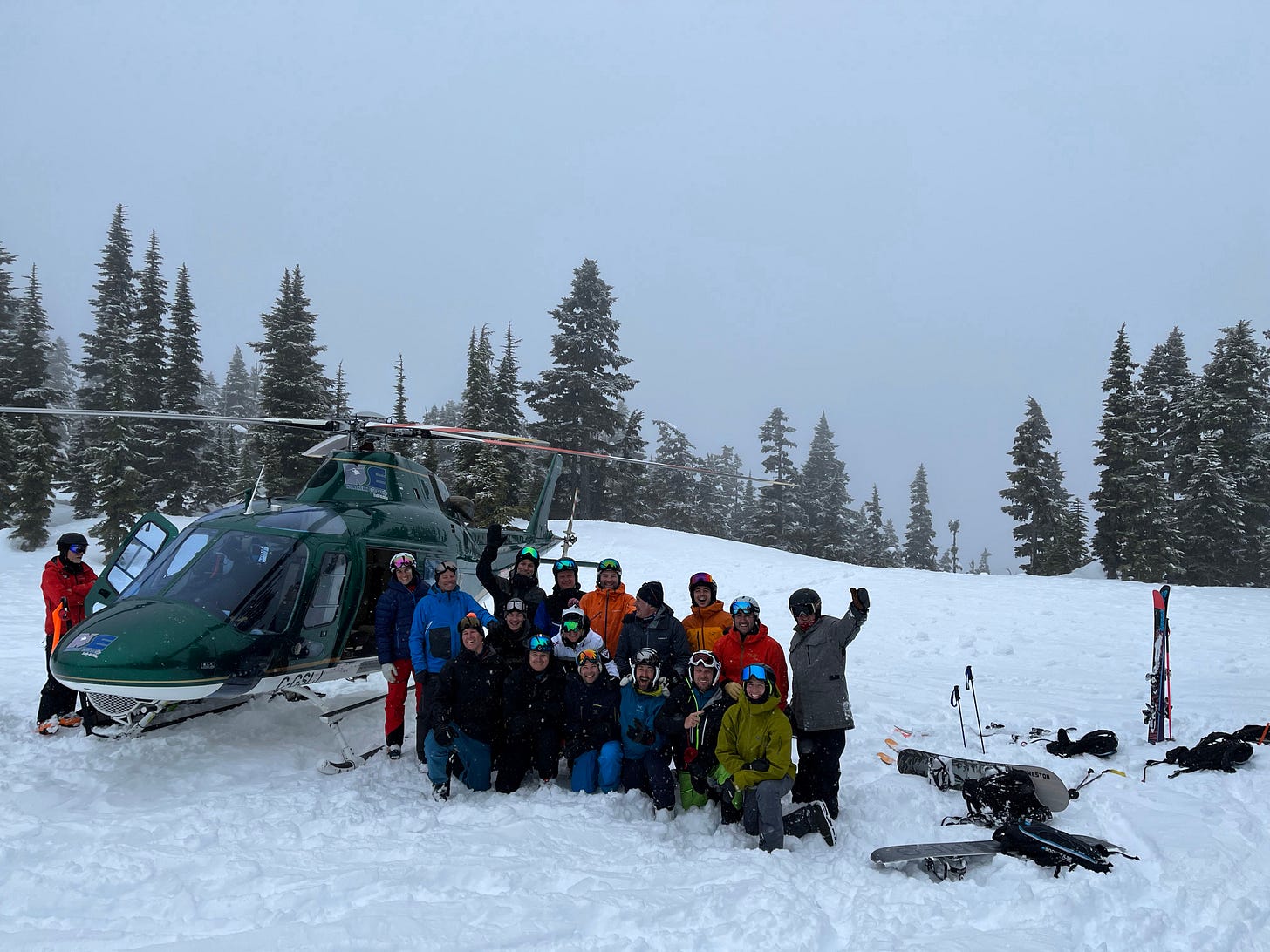A Challenge To Free Up Your Time
Plus, Remote Focus: Heli-skiing in northern British Columbia
Hey reader,
I frequently find myself overbooked. Especially since becoming a dad. Work and family commitments keep me quite busy, making any social or networking opps almost impossible.
As a remote worker, I find it almost too easy to overload myself with commitments — from zoom calls to masterminds to digital nomad social and networking groups. All have the best of intentions, but as is true with so many things in life, some deliver value much more clearly than others.
Today’s essay is designed to help you — and me — trim the fat. We’ll work through a simple exercise I designed to help you determine the value you are getting from your non-work and non-family commitments.
All it takes is five to ten minutes and either a blank Google Doc, piece of paper, or Note on your phone. I hope you find it as useful as I did.
And below, today’s edition of Remote Focus will surely stoke you out for the arrival of spring and more stable backcountry conditions — the gallery chronicles a four-day heliski trip in northern British Columbia from which I just returned.
Community Shoutouts
Big thanks to Yarty and his awesome (and free) Substack newsletter, Kick Ass Letters. I originally created today’s exercise for his newsletter, and am honored to have been included in what has become my favorite bi-weekly quick read.
On that note, welcome to the 15 subscribers since the past newsletter, including a few of you who came from Kick Ass Letters — welcome! Lots of mountain stoke and remote work inspiration coming your way on Fridays.
One final shout-out to Sue for opting into a paid subscription to Mountain Remote, and for the kind email after the last dispatch. I really appreciate your support :-)
And now, let’s trim some fat.
Trim the fat off your communities and groups
We've all heard of those apps that help you monitor and cancel subscriptions to save money. This exercise will do the same thing for your personal commitments. We'll start by making a list of all of the groups, clubs, and other non-work and non-family activities you are committed to on at least a monthly basis.
Then, we'll assign value points to each to determine whether you're ACTUALLY getting the promised value from them. By the end, you'll have a clear vision of which commitments are worth the time and effort, and which ones you need to bail on.
This is extremely helpful for those experiencing a hectic collision between professional and personal life: such as myself, for example. I recently became a parent and am living the chaos of balancing work, family, and everything else.
Here we go!
Open a new Note in your phone or a fresh Google Doc.
Create a bullet list as follows (you can of course add additional criteria, however, don't go too crazy -- the idea is to keep it simple and force your commitments to prove their value immediately.) We'll call these criteria "Adds."
Financial/business Add (i.e. a lead gen group that continually sends good leads)
Networking Add (i.e. a meetup group or coworking membership that regularly allows you to meet inspiring/influential people or others who may help your career in some way)
Mindfulness, Fitness, or Adventure Add (a weekly hiking meetup or fitness class, or a meditation/spiritual group)
Giving Back Add (volunteer opp, serving on a board of directors/advisors, etc.)
Now, make a list of all of the clubs, groups, and memberships you are a part of. Mine looks like this, in part:
Palisade Tourism Advisory Board - Free
Giving back
Networking (meeting influential people in my town)
Community Food Bank volunteer - Free
Giving back
Transformational Travel Council (group of journalists who meet once per month on zoom) - Free
Networking
Dynamite Circle (remote work/business development community) $500/year
Financial/business
Networking
Remote work networking community 1 - $150/year
None
Remote work networking community 2 - $100/year
Financial/business
Gym membership - $30/month
Fitness
Business — I claim business here because I have to be in shape to do story assignments covering heli-ski trips, ya know?
North American Travel Journalists Association (professional org) - about $200/year
None
Two different mastermind groups - Free
Networking
Financial/Business
How to determine if a community or group is worth your time:
A successful membership or group hits at least two of these targets. As you can see from my examples above, I have five groups that are not meeting that target, and due to the need to free up time and mental bandwidth, I should consider stepping away from them.
Most of these would be a permanent departure, while the Community Food Bank volunteer opp could be a temporary step back until I feel more in control of my schedule.
Note: Since running through this exercise, I have canceled my membership to Remote Work Networking Community #1, stopped my auto-renewal on Remote Work Networking Group #2, temporarily stepped away from the food bank, and canceled the auto-renew on the travel journalist association. Win!
Also noted here is the cost, which can play a factor in your decision-making if it needs to. The only relatively pricey group on my list is the Dynamite Circle, which hits at least two of the “Adds” and in my opinion, is worth the spend.
After running through this simple exercise, you are likely to find at least one or two commitments that can be removed from your schedule.
How did you do? Hit Reply and let me know!
Dig this essay? Hit the button below:
Remote Focus: Heli-skiing in northern British Columbia
I returned last week ago from a trip I’d dreamed of taking since high school: a multi-day heli-skiing expedition way up north. I booked with Nothern Escape Heliskiing out of Terrace, BC, and embarked on a four-day package that included a room at their Yellow Cedar Lodge, just off the gorgeous Skeena River, and all food throughout the stay.
(For the full story on the trip, including all the logistics, see this article I wrote for Matador Network).
Takeaways from the trip:
The logistics of a heli-skiing operation are incredibly complex. Factors including wind, snow, and visibility play a prime role in whether or not the chopper can fly — but of course, avalanche conditions and snow stability play an equally large role in determining where terrain can be ridden.
Northern Escape is a carbon-neutral operation, offsetting its carbon footprint including that of the helicopters. This is a major reason why I chose to go with this operator over the others in the area.
In addition, Northern Escape offers a catskiing backup option on days when the choppers can’t fly. On the third day of my trip, the mountains were socked in above treeline in the morning, allowing us only one heli run before conditions were too dangerous to fly. We spent the rest of the morning in “Catland,” taking runs on the snowcat — no lost time on the mountain. Conditions cleared in the afternoon and we were back in the air.
Despite being 100% backcountry, Northern Escape operates in a defined “tenure” of terrain, and has a detailed map of “runs” that guides lead skiers and boarders on. Each day, runs are given a “green” or “red” rating, meaning rideable or not rideable.
When conditions are not very stable, multiple laps will happen on the few runs that are. On our first day, we primarily rode two runs most of the day — but because it’s high alpine big mountain riding, and there is no one else out there, we still had fresh tracks on every turn.
When heli-skiing, you are dropped off at designated landing zones and ski down to another landing zone at the bottom. Guides lead the way.
Destination: North of Terrace, British Columbia. Flights into Northwest Regional Airport in Terrace.
Dates: March 4-8, 2022
Crew: Myself, a group of 12 skiers from France, a couple from Germany, and three guys from New York City.
Stats: Total vert on the trip topped 65,000 feet. On day one alone, we hit 28,000 on 16 runs.
Wind crust forms on the peaks. After very short traverses, we drop into wide-open bowls and faces.
The landing zone at the bottom of a run off of Alice Peak.
We dropped left, avoiding the terrain traps. But look up — that’s the real beauty here.
Paul and Ricarda in front of a gnarly serac. Much of the low-angle terrain is glaciated, where we were riding on top of a glacier. Seracs and crevasses were consistent hazards. However, the guides sawed off a block of ice to use in cocktails at happy hour.
The chopper flying above one of our few runs below treeline.
Typical terrain in the north Coast Mountains — wide-open faces lined with rollers and bumps. Treeline in BC is about 4,200 feet, so even the peaks are a descent from home in Colorado. But the terrain is massive.
We dropped in just to the left on this run. Credit: Louis Pellard
It’s eery and mystical when the clouds come in. Credit: Louis Pellard
We stopped just ahead of one of the other groups and I got this shot of them waiting for the chopper, just as the clouds came in.
The crew — from France, Germany, New York, and Colorado.
I drink a lot of coffee putting Mountain Remote together.
Mountain Remote news and further reading
Check out Kick Ass Letters on Substack and on Twitter — every two weeks, Yarty sends out a challenge to help you optimize an aspect of your life. The exercise here in this newsletter was an example.
My article for Matador Network about the heliski trip with Northern Escape ran this week.
As we continue into the ever-changing “new normal,” here’s a look at what to expect in the future of work (i.e. remote work).
Thanks for reading!













